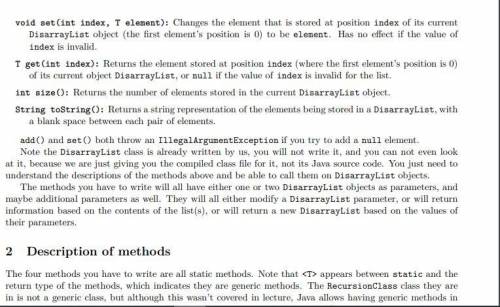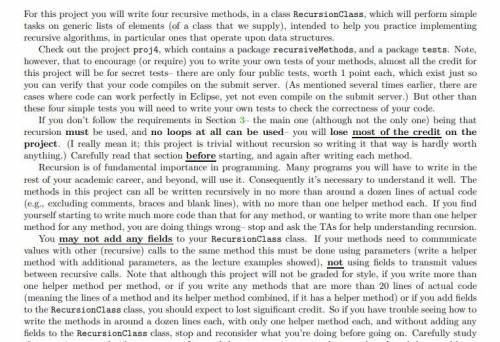Most of question in images
2.1 static T elementAfter(DisarrayList list, T element)
This meth...

Computers and Technology, 20.10.2021 21:40 Bri0929
Most of question in images
2.1 static T elementAfter(DisarrayList list, T element)
This method should return the element in its parameter list that is in the position immediately after the
first occurrence of element (“first” means closest to the beginning). If element is not present in elements
at all (which would always be the case if elements is empty) the method should just return null. If element
is the very last element in elements the method should also return null.
2.2 static boolean areReversed(DisarrayList list1, DisarrayList list2)
This method should return true if its two list parameters list1 and list2 have all the same elements, and
only the same elements, but in the exact opposite order (i. e., if one’s elements are in the reverse order of the
other’s). Otherwise it should return false. Note that two lists that are empty are obviously (and trivially)
each both the reverse of the other. Two one–element lists are the reverse of each other only if the two elements
are the same.
Your method must follow the requirements in Section 3, or you will not receive credit for it, so read that
section carefully, before starting to code.
2.3 static void replaceNthOccurrence(DisarrayList list, T elt, T newElt,
int n)
This method should find the n’th occurrence of elt in its parameter list, if there is one, and replace it with
the value newElt. n’th refers to the value of the method’s fourth parameter, and “n’th occurrence” means the
n’th occurrence from the beginning of the list. (n will be 1 to indicate the first occurrence of elt is the one
that should be replaced.)
If elt is not present in list, or if it is present but there are fewer than n occurrences of it in the list,
the list will be unchanged. If list is empty then it will remain unchanged because in that case it obviously
cannot have any occurrences of elt. If there are more than n occurrences of elt in the list only the n’th one
should be replaced by newElt.
Note that this method may modify its parameter list. (It is the only one of the four methods that can.)
Besides throwing an IllegalArgumentException if any reference parameter is null, as described above,
this method should also throw this exception if n is zero or less, because it is impossible for a list to have a
zero’th occurrence, or a negative occurrence, of an element.
Your method must follow the requirements in Section 3, or you will not receive credit for it, so read that
section carefully, before starting to code.
2.4 static DisarrayList omitAfter(DisarrayList list, T element)
This method should return a new DisarrayList (that will have the same element type as its parameter
list) that contains the elements of its parameter list except that the single element after each occurrence
of element has been skipped, and not included in the result list. If there is no element after an occurrence
of element (meaning if it is the last element of the parameter list) then of course nothing will be omitted
after that occurrence. For example, if list contains the elements 1, 3, 2, and 4, and element is 3, then the
result list will contain 1, 3, and 4 (and list itself will not have been modified).
Note that if a skipped or omitted element happens to be equal to element, the element after it is not
omitted, because the skipped element will not even be considered by the method. For example, if list
contains 1, 3, 3, 3, 4, and 5 and 3 is passed into element, the result list will contain 1, 3, and 5– the first 3
has the effect of causing the second 3 to be ignored, so the method doesn’t even notice that it is a 3. Then
when it sees the third 3, which is not ignored, it omits or skips the 4.
Note that the returned list and the parameter list must be structurally independent, so subsequently
changing either of them (adding elements to or removing elements from either list) will not affect the other.
(Only the actual data elements themselves will be aliased between the two lists.)





Answers: 1


Another question on Computers and Technology

Computers and Technology, 22.06.2019 13:00
Which option should u select to ignore all tracked changes in a document
Answers: 1

Computers and Technology, 23.06.2019 01:20
Write a function balancechemical to balance chemical reactions by solving a linear set of equations. the inputs arguments are: reagents: symbols of reagents in string row array products: symbols of products in string row array elements: elements in the reaction in string row array elcmpreag: elemental composition of reactants in two dimensional numeric array elcmpprdcts: elemental composition of prducts in two dimensional numeric array hint: the first part of the problem is setting up the set of linear equations that should be solve. the second part of the problem is to find the integers from the solution. one way to do this is to mulitiply the rational basis for the nullspace by increasing larger integers until both the left-and right-side integers exist. for example, for the reaction that involves reacting with to produce and : reagents=["ch4", "o2"]; products =["co2", "h2o"]; elements =["c","h", "o"] elcmpreag=[1,4,0;
Answers: 3

Computers and Technology, 23.06.2019 19:00
Whose task it is to ensure that the product flows logically from one step to another?
Answers: 3

Computers and Technology, 23.06.2019 19:30
You can apply several different worksheet themes from which tab?
Answers: 1
You know the right answer?
Questions

Mathematics, 08.03.2021 05:30

Health, 08.03.2021 05:30

English, 08.03.2021 05:30

History, 08.03.2021 05:30

Mathematics, 08.03.2021 05:30

Mathematics, 08.03.2021 05:30


Social Studies, 08.03.2021 05:30









Mathematics, 08.03.2021 05:30

Mathematics, 08.03.2021 05:30

Chemistry, 08.03.2021 05:30



